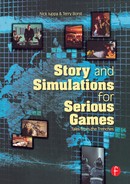Introduction:
The Road to StoryDrive
Northeastern Bosnia, 1998. The refugees of ethnic conflict are returning. But they aren’t welcome. Paramilitary thugs are determined to drive them out and drag their NATO protectors into a mire of guerrilla attacks and urban combat.
In the town of Celic, a platoon of U.S. peacekeeping troops inspects a Weapons Storage Site. Weapons are missing and a hostile crowd has surrounded the site. The Platoon Leader radios for assistance.
At the Brigade Tactical Operation Center . . .
The BATTLE CAPTAIN picks up the call—and the job of launching a rescue mission. His Commander instructs him to “Deliver the force with speed and surprise.” The Battle Captain’s response: Operation Cobra Strike. Mission: secure the town of Celic and neutralize the threat. Action: An air assault force will establish a cordon and seal the town. Mechanized infantry will roll in, rescue the weapons inspection team and protect the residents and refugees.
The Battle Captain broadcasts the order to all units: load up and get ready to roll.
At that moment a call from the Platoon Leader at the Weapons Storage Site reports that the crowd has grown larger and that shots have been fired at his troops.
So reads the description of a new kind of military simulation: one that attempts to engage users in a collaborative exercise in which they take on the roles of the Battle Captain and his staff and attempt to engineer the rescue of the endangered platoon. It is a simulation driven by a story that was designed, written and created by a Hollywood motion picture studio.
The exercise represents one of the first and most important efforts in the difficult struggle to bring the full power and effect of storytelling into the realm of simulation. The benefits of story in simulation training have been quite apparent to the US military and to trainers and game designers alike. Stories can engage participants, make their experience more memorable, help them learn, and help them transfer that learning to the real world. Stories can portray the full complexity of a difficult situation; they can induce the kind of tension and stress that learners must become familiar with when it becomes a major part of their jobs.
These are all things that a good Hollywood movie can achieve through cinematic storytelling. But the mechanics of combining the structure of a good story with the sense of free will needed to have a believable simulation have always seemed difficult or impossible to achieve.
The book you’re holding in your hands addresses this challenge. And to see how this can benefit you, read on.
